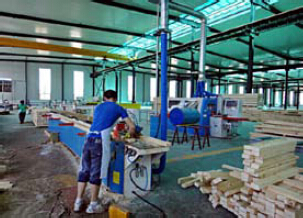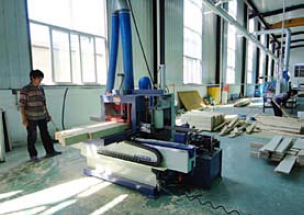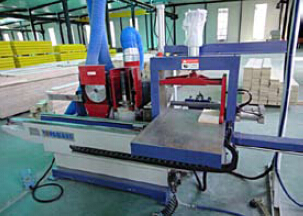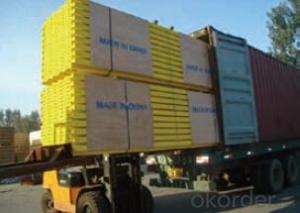Timber Beam H20 for formwork and scaffolding systems
- Loading Port:
- Tianjin
- Payment Terms:
- TT OR LC
- Min Order Qty:
- 50 m²
- Supply Capability:
- 1000 m²/month
OKorder Service Pledge
Quality Product, Order Online Tracking, Timely Delivery
OKorder Financial Service
Credit Rating, Credit Services, Credit Purchasing
You Might Also Like
Characteristics:
◆ Standardized production lines.
Supply capability: 3000m/day, Lmax = 6600mm.
◆ Finger jointing of the flange and web, the strength of timber beam is highly improved.
Max. shearing force failure load:40KN
◆ Well treated to prevent from water penetration or erosion, so the service life maximally extended.
Normally, CNBM timber beam H20 can be used for 4 to 5 years, the exact using time would depend on maintenance & storage.
◆ Robust caps at the end of the girders protect against damages.




- Q:How does steel formwork perform in seismic zones?
- Steel formwork performs well in seismic zones due to its high strength and durability. Steel is known for its excellent load-bearing capacity and resistance to bending and shearing forces, making it suitable for withstanding the intense shaking and vibrations caused by earthquakes. In seismic zones, the ground experiences significant movement during an earthquake, which can put immense pressure on the formwork system. Steel formwork, being rigid and robust, is able to withstand these forces without any significant deformation or damage. This ensures the stability and integrity of the structure during and after the seismic event. Additionally, steel formwork offers flexibility in design and construction, allowing for the creation of reinforced concrete structures that are better equipped to handle seismic loads. The use of steel formwork enables the incorporation of additional reinforcement elements, such as steel bars and mesh, which enhance the overall strength and ductility of the structure. This helps in dissipating the energy generated by seismic forces and reducing the risk of structural failure. Moreover, steel formwork is reusable and can be easily dismantled and reassembled, making it a cost-effective and sustainable choice for construction in seismic zones. This flexibility allows for the quick repair and reconstruction of structures in the event of earthquake damage, minimizing downtime and ensuring the safety of occupants. Overall, steel formwork is a reliable and resilient choice for construction in seismic zones. Its strength, durability, and flexibility make it well-suited to withstand the forces generated by earthquakes, ensuring the safety and stability of structures in these high-risk areas.
- Q:Can steel formwork be used in cultural or entertainment facility construction projects?
- Cultural or entertainment facility construction projects can indeed utilize steel formwork. This type of formwork possesses various advantages, including durability, strength, and the ability to withstand heavy loads. These characteristics make it a suitable choice for constructing the large and intricate structures commonly found in cultural and entertainment facilities, such as theaters, concert halls, museums, and stadiums. Furthermore, steel formwork can be easily tailored to meet the specific design requirements of these facilities, thereby offering flexibility and efficiency during the construction process. Additionally, the reusability of steel formwork contributes to cost savings and a reduced environmental impact. In conclusion, considering its strength, durability, flexibility, and cost-effectiveness, steel formwork presents itself as a viable option for cultural or entertainment facility construction projects.
- Q:Can steel formwork be used for water retaining structures?
- Water retaining structures can indeed utilize steel formwork. One of the notable characteristics of steel formwork is its strength, durability, and ability to withstand high pressures. When designed and constructed correctly, steel formwork can establish a watertight seal and effectively resist the hydrostatic pressure exerted by water. Moreover, steel formwork facilitates a uniform and smooth finish, minimizing the chances of water leakage. However, it is crucial to implement appropriate waterproofing measures, including the use of suitable sealing materials and techniques, to prevent potential water leakage or seepage through joints or connections. Consistent inspection and maintenance are also indispensable to ensure the long-term integrity of the water retaining structure.
- Q:What are the typical sheet thicknesses used in steel formwork panels?
- The typical sheet thicknesses used in steel formwork panels vary depending on the specific application and requirements, but they commonly range from 2mm to 6mm.
- Q:Can steel formwork be used in seismic zones?
- Steel formwork is indeed capable of being employed in seismic zones. Steel possesses formidable strength and durability, enabling it to endure the formidable forces unleashed during an earthquake. The material exhibits a remarkable ability to flex and absorb energy, rendering it highly suitable for deployment in seismic zones. Furthermore, steel formwork confers stability and rigidity upon the structure, guaranteeing its ability to withstand the quivering and shifting caused by seismic activity. Nonetheless, it is essential to take into account other factors such as design, construction techniques, and local building codes to ensure the correct installation and compliance of the steel formwork system with the specific requirements of the seismic zone.
- Q:What is the maximum load that steel formwork can bear?
- The maximum load that steel formwork can bear depends on various factors such as the type and thickness of the steel used, the design and construction of the formwork, and the support system in place. Steel formwork is known for its strength and durability, making it capable of supporting heavy loads. However, it is important to consult the manufacturer's specifications and guidelines to determine the exact maximum load capacity of a particular steel formwork system. These specifications are typically based on extensive testing and engineering calculations, ensuring the safety and structural integrity of the formwork. Additionally, it is crucial to consider other factors such as the load distribution, formwork layout, and the overall stability of the structure. Professional engineers and contractors should be involved in the design and installation process to ensure that the maximum load capacity is not exceeded and that the formwork is safely supported throughout the construction process.
- Q:Can steel formwork be used for both single-sided and double-sided forming?
- Steel formwork is capable of being utilized for both single-sided and double-sided forming. Renowned for its strength and durability, steel formwork is well-suited for various construction applications. In the case of single-sided forming, the steel panels are firmly secured against a solid surface or pre-existing structure, acting as a barrier to retain the concrete until it solidifies. Conversely, for double-sided forming, steel formwork panels are employed on both sides of the concrete pour, creating a mold that holds the concrete in place and provides a sleek finish on both sides of the structure. The versatility of steel formwork permits its utilization in a wide array of construction projects, encompassing walls, columns, beams, slabs, and more.
- Q:What are the considerations when designing steel formwork for beams?
- When designing steel formwork for beams, there are several important considerations to take into account. Firstly, the formwork needs to be strong and durable enough to support the weight of the concrete and any additional loads, such as construction personnel or equipment. The formwork should also be designed to withstand the pressure and vibrations caused by the pouring and consolidation of the concrete. Additionally, the formwork should be designed to provide easy access for placing and compacting the concrete. This may involve incorporating openings or removable sections to allow for the proper placement and consolidation of the concrete. Furthermore, the design should consider the ease of assembly, disassembly, and reusability of the formwork. Steel formwork is often preferred due to its strength and reusability, so the design should be efficient in terms of assembly and disassembly to minimize labor and time. Lastly, safety is a crucial consideration. The formwork should be designed to ensure the safety of workers during the construction process. This may involve incorporating features such as guardrails, non-slip surfaces, or other safety measures to prevent accidents or falls. In summary, when designing steel formwork for beams, factors such as strength, durability, accessibility, reusability, and safety should all be carefully considered to ensure a successful and efficient construction process.
- Q:Can steel formwork be used for both vertical and inclined concrete placements?
- Yes, steel formwork can be used for both vertical and inclined concrete placements. Steel formwork is known for its high strength and durability, making it suitable for various construction applications. Whether it is a vertical wall or an inclined surface, steel formwork can provide the necessary support and shape to hold the concrete in place until it sets and hardens. Steel formwork offers flexibility in terms of shape and design, allowing it to be easily adjusted and adapted for inclined placements. The formwork panels can be connected and fixed at different angles to create the desired inclination. This flexibility enables contractors to construct structures with various slopes, such as ramps, stairs, and inclined walls. Furthermore, steel formwork can withstand the pressure exerted by the fresh concrete during the pouring and curing process. It provides a stable and secure framework that prevents the concrete from collapsing or deforming. This is particularly important when dealing with inclined placements, as the concrete tends to exert more lateral pressure on the formwork. Additionally, steel formwork offers the advantage of being reusable. Unlike traditional timber formwork, steel formwork can be easily dismantled and reassembled for future projects. This not only reduces construction costs but also minimizes waste and environmental impact. In conclusion, steel formwork is a versatile solution that can be used for both vertical and inclined concrete placements. Its strength, durability, and adaptability make it an ideal choice for various construction projects.
- Q:What are the standard dimensions of steel formwork panels?
- The standard dimensions of steel formwork panels can vary, but they are typically around 2.4 meters in length and 0.6 meters in width. The thickness of these panels can range from 12mm to 20mm. However, it is important to note that these dimensions can vary depending on the specific project requirements and the formwork manufacturer.
1. Manufacturer Overview |
|
|---|---|
| Location | |
| Year Established | |
| Annual Output Value | |
| Main Markets | |
| Company Certifications | |
2. Manufacturer Certificates |
|
|---|---|
| a) Certification Name | |
| Range | |
| Reference | |
| Validity Period | |
3. Manufacturer Capability |
|
|---|---|
| a)Trade Capacity | |
| Nearest Port | |
| Export Percentage | |
| No.of Employees in Trade Department | |
| Language Spoken: | |
| b)Factory Information | |
| Factory Size: | |
| No. of Production Lines | |
| Contract Manufacturing | |
| Product Price Range | |
Send your message to us
Timber Beam H20 for formwork and scaffolding systems
- Loading Port:
- Tianjin
- Payment Terms:
- TT OR LC
- Min Order Qty:
- 50 m²
- Supply Capability:
- 1000 m²/month
OKorder Service Pledge
Quality Product, Order Online Tracking, Timely Delivery
OKorder Financial Service
Credit Rating, Credit Services, Credit Purchasing
Similar products
New products
Hot products
Related keywords






















